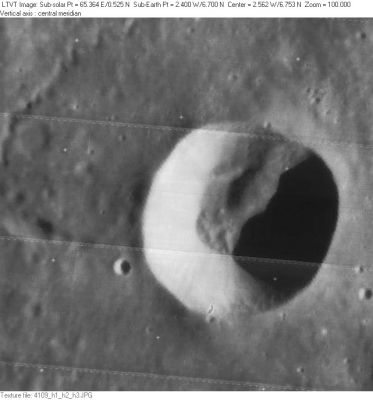Bode
Contents
Bode
|
Lat: 6.7°N, Long: 2.4°W, Diam: 18 km, Depth: 3.48 km, Rükl: 33 |
LO-IV-109H A sinuous rille (known as Rima Bode III in the System of Lunar Craters) appears to begin in the unnamed elongated pit near the center left margin, and then winds north across the surrounding mare (visible in upper left corner of this frame).
Images
LPOD Photo Gallery Lunar Orbiter Images Apollo Images
Bowl-shaped crater Bode was photographed during the scientific J-missions of Apollo 15, 16, and 17.
- Apollo 15, Revolution 71:
At the central part of the curved horizon in the southward looking Fairchild camera frame AS15-M-2575.
- Apollo 16, Revolution 27:
At the central part of the curved horizon in the northward looking Fairchild camera frame AS16-M-845.
- Apollo 17, Revolution 65:
At the central part of the curved horizon in the southward looking Fairchild camera frame AS17-M-2430.
- Research Apollo 15, 16, and 17 photography: Danny Caes
Maps
(LAC zone 59D2) LAC map Geologic map AIC map
Description
Description: Elger
(IAU Directions) BODE.--A brilliant ring-plain, 9 miles in diameter, situated on the N. side of Pallas. Its walls rise about 5,000 feet above the interior, which is considerably depressed, and includes, according to Schmidt and Webb, a mountain or ridge. There are two parallel valleys on the E., which are well worth examination.
Description: Wikipedia
Additional Information
- Depth data from Kurt Fisher database
- Arthur, 1974: 3.48 km
- Westfall, 2000: 3.48 km
- Viscardy, 1985: 3.5 km
- Cherrington, 1969: 2.19 km
- From the shadows in LO-IV-109H, Bode is about 3600 m deep. The ridge crossing the north floor is up to 700 m above the floor. - Jim Mosher
- The ridge was measured at less than 800m by Sekiguchi Sekiguchi, 1972. - fatastronomer fatastronomer
- Bode and its satellite crater A are included in ALPO list of bright ray craters
- Bode and its satellite craters A and B are on the ALPO list of banded craters
Nomenclature
- Named for Johann Elert Bode (January 19, 1747 – November 23, 1826), a German astronomer known for his reformulation and popularization of the Titius-Bode law as well as his works to determine the orbit of Uranus, for which he also suggested the name. He is also credited with the discovery of Bode's Galaxy (M81).
- This name was one of eight names introduced by Lohrmann (Whitaker, p. 119). All of Lohrmann's names were adopted by the three "authorities" cited in Mary Blagg's Collated List, and incorporated into the original IAU nomenclature of Blagg and Müller (1935).
- The rough region between Sinus Aestuum and Mare Vaporum is known as the Bode Pyroclastics. This unofficial name is incorporated on charts 17 and 18 of the 21st Century Atlas of the Moon (C.A. Wood/ M. Collins).
- Rima Bode E (an unofficial name from a dedicated investigator of lunar rilles for the rille north of Bode E).
LPOD Articles
Bibliography
- Gaddis, L. R., C. M. Pieters & B. R. Hawke (1985). Remote sensing of lunar pyroclastic mantling deposits. Icarus 61, 461-489.
- Hawke, B. R., C. R. Coombs, B. A. Campbell, P. G. Lucey, C. A. Peterson & H. Zisk (1991). Remote sensing of regional pyroclastic deposits on the north central portions of the lunar nearside. Proc. Lunar Planet. Sci. 21, 377-389.
J. E. Bode in the Sourcebook Project (William R. Corliss)
- In Mysterious Universe, a handbook of astronomical anomalies (1979) :
- Page 500: Huth's "Moving Star" of 1801-2 (Nature, 1876). The strange story of Hofrath Huth and his supposed discovery of an enigmatic celestial object on the night of December 2 to 3, 1801.
- Page 543: A Relation between the Mean Distances of the Planets from the Sun (A.E.Caswell, Science, 1929).
- Page 546: A New Law of Satellite Distances (J.B.Penniston, Science, 1930).
- Page 557: Bode's Law and the Missing Planet (M.W.Ovenden, Nature, 1972).
- Page 560: The Titius-Bode Law and the Evolution of the Solar System (M.M.Nieto, Pensee, 1974) (Icarus, 1974).
